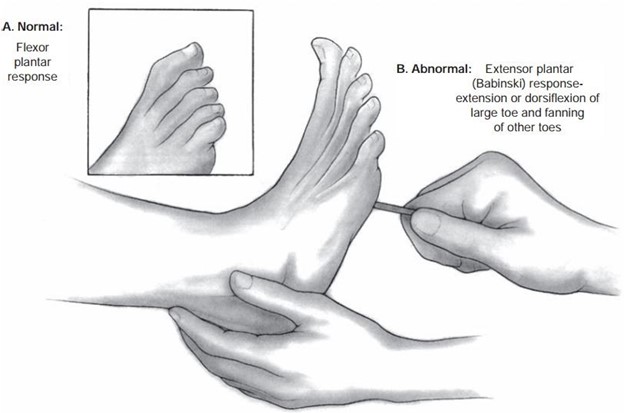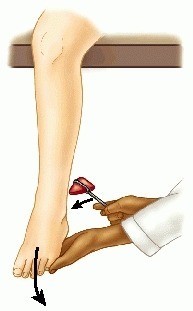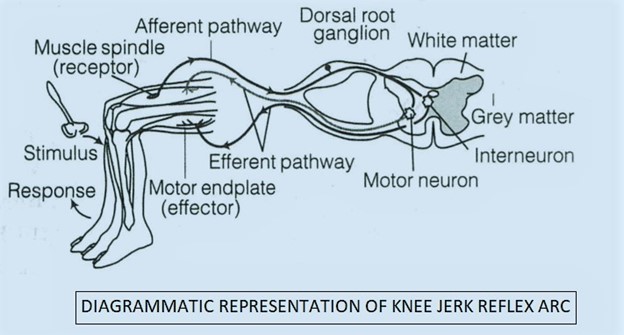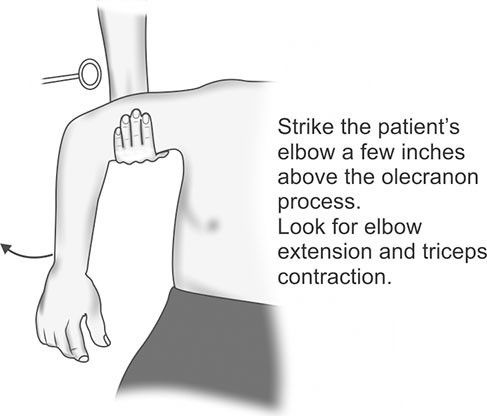A nurse is preparing to test a client's plantar Babinski reflex. Which of the following instructions should the nurse give to prepare the client for this test?
"Place your foot in my hand and I will tap the back of your heel."
"Lie down and I will stroke the bottom of your foot."
"Sit on the edge of the bed while I tap your knee."
"Relax your arm across your chest and I will test your elbow extension."
The Correct Answer is B
The plantar Babinski reflex is assessed by stroking the sole of the foot from the heel towards the toes. A normal response is the flexion or curling of the toes. An abnormal response, known as a positive Babinski sign, is the extension and fanning out of the toes, which indicates an upper motor neuron lesion.

"Place your foot in my hand and I will tap the back of your heel": This instruction is more relevant to testing the Achilles tendon reflex, where the nurse taps the back of the heel to elicit a plantarflexion response.

"Sit on the edge of the bed while I tap your knee": This instruction is more relevant to testing the patellar reflex, also known as the knee-jerk reflex. The nurse taps the patellar tendon just below the kneecap to elicit a reflexive contraction of the quadriceps muscle.

"Relax your arm across your chest and I will test your elbow extension": This instruction is more relevant to testing the triceps reflex, where the nurse taps the triceps tendon to elicit a reflexive extension of the elbow.

Nursing Test Bank
Naxlex Comprehensive Predictor Exams
Related Questions
Correct Answer is D
Explanation
Potassium is an essential electrolyte that plays a crucial role in various bodily functions. However, for individuals with an electrolyte imbalance, it is often necessary to limit their potassium intake. Among the options provided, baked chicken breast is the lowest in potassium. Cantaloupe is relatively high in potassium. A cup of diced cantaloupe contains about 430 mg of potassium.
Sweet potatoes are known for their high potassium content. A medium-sized sweet potato with skin contains about 542 mg of potassium.
Orange juice also contains a moderate amount of potassium. An 8-ounce serving of orange juice typically contains around 450 mg of potassium.
Chicken breast is naturally low in potassium compared to fruits and vegetables. It contains about 260 mg of potassium per 4-ounce serving.
Therefore, among the given options, the baked chicken breast is the lowest in potassium and would be the most suitable choice for a client with an electrolyte imbalance requiring a low-potassium diet.
Correct Answer is A
Explanation
Explanation
A. Chadwick’s sign
Chadwick's sign is a characteristic change that occurs during pregnancy, specifically in the cervix, vagina, and vulva. It is characterized by a bluish or purplish discoloration of these areas.
Chloasma in (option B) is incorrect because it is a condition characterized by the development of dark patches on the skin, commonly referred to as "mask of pregnancy." Chloasma typically affects the face, particularly the cheeks, forehead, and upper lip. It is not associated with a change in colour in the vaginal or vulvar area.
Hegar's sign in (option C) is incorrect because it is a softening of the lower uterine segment that can be felt during a pelvic examination. It is not related to the colour changes in the vaginal or vulvar area.
Ballottement in (option D) is incorrect because it is a palpation technique used during a prenatal examination to assess the position of the foetus. It involves the examiner gently pushing against the uterus and feeling a rebound or "floating" movement of the foetus. It does not involve changes in the colour of the vaginal or vulvar area.

Whether you are a student looking to ace your exams or a practicing nurse seeking to enhance your expertise , our nursing education contents will empower you with the confidence and competence to make a difference in the lives of patients and become a respected leader in the healthcare field.
Visit Naxlex, invest in your future and unlock endless possibilities with our unparalleled nursing education contents today
Report Wrong Answer on the Current Question
Do you disagree with the answer? If yes, what is your expected answer? Explain.
Kindly be descriptive with the issue you are facing.
